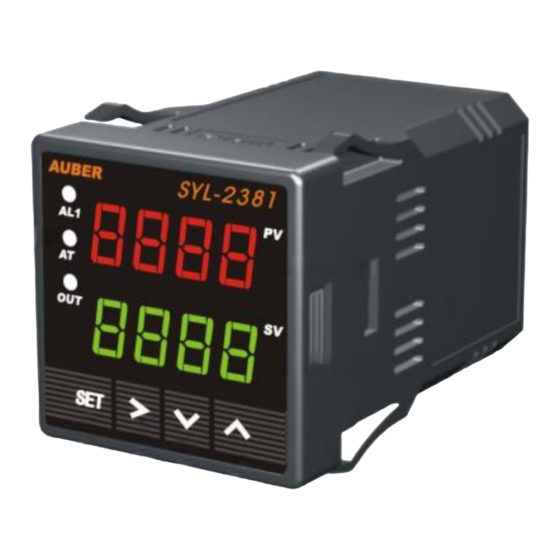Auber Instruments SYL-2381-mA Руководство по эксплуатации - Страница 5
Просмотреть онлайн или скачать pdf Руководство по эксплуатации для Контроллер температуры Auber Instruments SYL-2381-mA. Auber Instruments SYL-2381-mA 7 страниц.

AUBER INSTRUMENTS
6. Auto-tuning
The Auto-tuning function (also called self-tuning) can automatically optimize the
PID parameters for the system. The auto-tuning function will provide "ON/OFF
mode" (see 6.3 below for details) to heat up the system until it passes the set point,
then let it cool down. It will repeat this about three times. Based on the response
time of the system, the built-in artificial intelligence program will calculate and set
the PID parameters for the controller. If your system has a very slow response, the
auto-tuning could take a long time.
SV
ON OFF
Figure 8. Auto-tuning.
6.1 To start auto-tuning, press and hold > key about 3 seconds until the "AT"
indicator starts to blink, which indicates auto-tuning is in progress. When "AT"
stops blinking, the auto-tuning is finished. Now, the newly calculated PID
parameters are set to be used for the system. Please note that auto-tuning is only
for PID control mode (when "outy" is set at 1, 2 or 3).
6.2 To stop the Auto-tuning, press and hold > key about 3 seconds until "AT"
indicator stops blinking. In this case, no new PID parameters are calculated. The
control will resume PID control with previous PID parameters.
6.3 In SYL-2381-mA. auto-tune can be used for J1 relay as main output modes
(OUTY = 3 or 4) and linear output as main output modes (OUTY = 1 or 2). When
you run auto-tune with linear output heating modes (OUTY = 1 or 2, RD = 0), the
linear output will be either 100% (when your PV is below your SV) or 0% (when
your PV is over your SV).
7. On/off control mode
In on/off control mode, the controller works like a mechanical thermostat. It simply
turns on or off the output when PV is below or above the SV. On/off control is not
as precise as PID control mode. However, this control mode is suitable for
inductive loads such as motors, compressors, or solenoid valves that do not like
pulsed power.
When the temperature passes the set point, the heater (or cooler) will be turned
off. When the temperature drops back to below the hysteresis band (Hy) the heater
will be turned on again. Please see the Note 4 in 5.1 for details.
On this controller, only J1 relay can be used for on/off control. To use the on/off
mode, set outy = 4. Then set Hy to a desired value based on the requirements of
the control precision. Smaller Hy values result in tighter temperature control, but
also cause the on/off action to occur more frequently. In the PID parameters menu
(code 0036), only ot and FILt settings will apply to on/off control mode. Settings
for other parameters P, I, D, and SouF have no effect on/off control.
2021.05
AT end
AT start
AT calculation
PV
OFF
ON
ON/OFF
PID
Figure 9. On/off control mode for heating (left) and cooling (right), in both
situations SV = 100 and Hy = 20.
8. Manual mode
Manual mode allows the user to manually adjust the output as a percentage of the
total output power. It is like a stove dial. The output is independent of the
temperature sensor reading. The manual control mode can only be switched from
PID control mode, not from on/off control mode. To switch from the PID mode to
manual mode, press and hold the SET key 4 seconds till the "AT" indicator turns
on. In manual mode, the SV window will show the percentage of the power output.
The very left digit in the SV window should show letter M (M). To switch from
manual mode to PID mode, press and hold SET key 4 seconds till the "AT"
indicator turns off. This controller offers "bumpless" switch from PID mode to
manual mode. For example, if the controller is sending 75% of power in PID mode,
when user switch to manual mode the controller will show "m 75" in the bottom
display, the output will stay at 75% till the user changes the output percentage.
9. Serial communication
RS485 serial communication is an optional feature available on SYL-2381-mA-S.
It complies with the widely-accepted MODBUS_RTU protocol. Please refer to the
supplementary manual for details.
10. Application Examples
10.1 A furnace needs to be controlled at 1200° F. The power source is 120 V AC.
The heating element is 1800 W at 120 V. It is switched on/off by a contactor. The
coil voltage of the contactor is 120 V AC. The temperature sensor is a type K
thermocouple.
a. Wiring diagram.
K type TC
+ -
6
7
8
9
10
11
13
12
14
1
2
3
4
5
Figure 10. A typical wiring set up for powder coating oven and kiln. This diagram
also applies to 240 V AC power system if both the heater and the coil voltage of
the contactor are 240 V AC.
WWW.AUBERINS.COM
Heater
Contactor
Fuse
L
120VAC
N
P5/7
